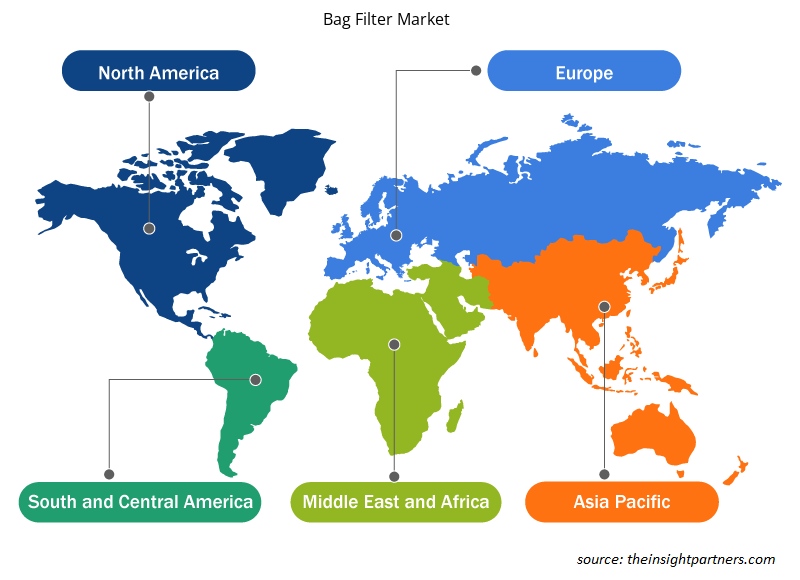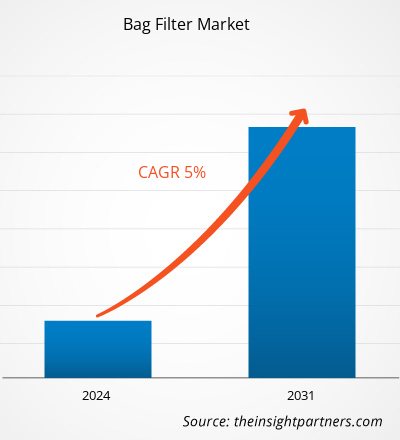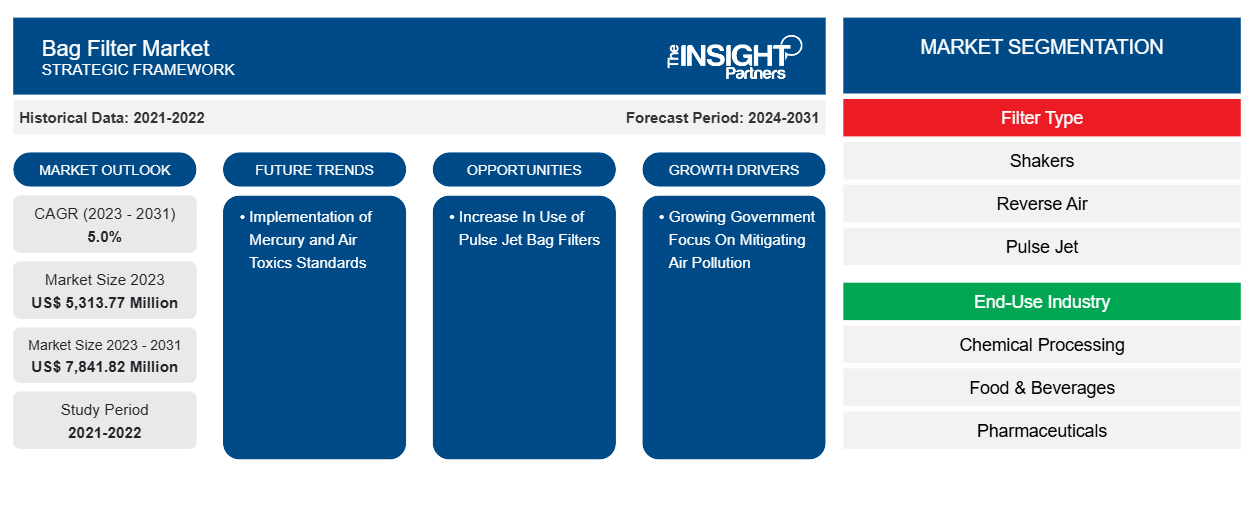袋式过滤器市场规模预计将从 2023 年的 53.1377 亿美元增至 2031 年的 78.4182 亿美元。预计 2023-2031 年期间市场复合年增长率将达到 5.0%。汞和空气毒物标准的应用可能仍是市场的主要趋势。
袋式过滤器市场分析
采矿和化学工业中使用的袋式过滤器外壳通常带有 ASME 标记,并且必须由不锈钢制成。过滤过程通常需要遵守严格的要求,并且通常能够过滤掉小于一微米的颗粒。功能性袋式过滤器的颗粒收集效率通常为 99% 或更高,无论颗粒尺寸有多小,这与静电除尘器不同,静电除尘器的性能会因工艺和电气条件的不同而有很大差异。一些袋式过滤器配备超声波喇叭,可产生额外的振动以改善除尘效果。喇叭在清洁周期开始前不久或开始时启动,以帮助打破过滤介质表面颗粒之间的结合。北美和西欧的发达国家已经实施了多项新限制措施,以遏制有害的工业排放。法律的频繁变化要求工厂中的袋式过滤器系统频繁进行现代化或升级。
袋式过滤器市场概况
市场上有多种袋式过滤器配置,这些过滤器经过独特设计,可满足操作需求。从标准袋式过滤器到定制设计的产品,制造商为客户提供不同类型的产品。由于成本低、可靠性高,工业袋式过滤器经常用于食品和饮料行业。反渗透或活性炭袋式过滤器被广泛用于净化水中的杂质。
定制此报告以满足您的需求
您可以免费定制任何报告,包括本报告的部分内容、国家级分析、Excel 数据包,以及为初创企业和大学提供优惠和折扣
-
获取此报告的关键市场趋势。这个免费样品将包括数据分析,从市场趋势到估计和预测。
袋式过滤器市场驱动因素和机遇
政府越来越重视减轻空气污染以利于市场
为了减少工业排放的影响并降低工业部门的排放水平,各国政府正在制定法律和法规以减轻空气污染。工业部门的不断发展和扩张以及城市化进程的加快预计将增加空气污染水平,这直接影响到健康并增加空气传播疾病的数量。因此,政府对降低空气污染水平的日益关注正引导政府将重点放在对工业部门实施严格的政策上,从而推动全球对袋式过滤器的需求。
脉冲袋式过滤器的使用增加
为了满足工作场所空气质量安全要求,脉冲喷射袋式过滤器是最流行的空气污染控制设备之一。脉冲喷射集尘器主要用于有效捕获和减少潜在的有毒颗粒物和排放。脉冲喷射过滤器的效率正在推动其在全球范围内的应用。
袋式过滤器市场报告细分分析
有助于得出袋式过滤器市场分析的关键部分是过滤器类型和最终用途行业。
- 根据过滤器类型,袋式过滤器市场分为振动器、反向空气和脉冲喷射器。脉冲喷射器部分在 2023 年占据了较大的市场份额。
- 根据最终用途行业,市场细分为化学加工、食品和饮料、制药、造纸和纸浆、水处理等。化学加工部门在 2023 年占据了相当大的市场份额。
袋式过滤器市场份额按地区分析
袋式过滤器市场报告的地理范围主要分为五个区域:北美洲、亚太地区、欧洲、中东和非洲、南美洲和中美洲。
北美引领市场。美国引领北美袋式过滤器市场。工业部门的不断发展和政府对减轻工业部门空气污染水平的日益重视,推动了北美袋式过滤器市场的增长。英国、法国、德国和比利时等国家是少数几个化学和食品饮料行业数量较多的国家,这推动了整个欧洲的增长。亚太地区水和废水处理设施数量的增加对整个亚太地区的袋式过滤器市场产生了积极影响。
袋式过滤器市场区域洞察
Insight Partners 的分析师已详尽解释了预测期内影响袋式过滤器市场的区域趋势和因素。本节还讨论了北美、欧洲、亚太地区、中东和非洲以及南美和中美洲的袋式过滤器市场细分和地理位置。

- 获取袋式过滤器市场的区域特定数据
袋式过滤器市场报告范围
| 报告属性 | 细节 |
|---|---|
| 2023 年的市场规模 | 53.1377亿美元 |
| 2031 年市场规模 | 78.4182亿美元 |
| 全球复合年增长率(2023 - 2031) | 5.0% |
| 史料 | 2021-2022 |
| 预测期 | 2024-2031 |
| 涵盖的领域 |
按筛选器类型
|
| 覆盖地区和国家 |
北美
|
| 市场领导者和主要公司简介 |
|
市场参与者密度:了解其对商业动态的影响
袋式过滤器市场正在快速增长,这得益于终端用户需求的不断增长,而这些需求又源于消费者偏好的不断变化、技术进步以及对产品优势的认识不断提高等因素。随着需求的增加,企业正在扩大其产品范围,进行创新以满足消费者的需求,并利用新兴趋势,从而进一步推动市场增长。
市场参与者密度是指在特定市场或行业内运营的企业或公司的分布情况。它表明在给定市场空间中,相对于其规模或总市场价值,有多少竞争对手(市场参与者)存在。
在袋式过滤器市场运营的主要公司有:
- 巴布科克与威尔科克斯企业公司
- BWF Offermann,Waldenfels&Co.KG
- 康斐尔
- 丹纳赫公司
- 唐纳森公司
- 伊顿公司
免责声明:上面列出的公司没有按照任何特定顺序排列。

- 获取袋式过滤器市场顶级关键参与者概述
袋式过滤器市场新闻和最新发展
通过收集一手和二手研究的定性和定量数据来评估袋式过滤器市场,其中包括重要的公司出版物、协会数据和数据库。袋式过滤器市场的一些发展情况如下:
- 派克汉尼汾公司 (Parker Hannifin Corp.) 推出了一款褶式袋式过滤器,可用于极热应用。(来源:派克汉尼汾公司,新闻稿,2022 年 5 月)
- Babcock & Wilcox 收购 FPS。Babcock and Wilcox Enterprises, Inc. 宣布收购知名天然气、氢气和可再生纸浆和造纸燃烧设备生产商 Fossil Power Systems, Inc.(来源:Babcock & Wilcox,新闻稿,2022 年 2 月)
袋式过滤器市场报告覆盖范围和交付成果
“袋式过滤器市场规模和预测(2021-2031)”报告对以下领域进行了详细的市场分析:
- 袋式过滤器市场规模及全球、区域和国家层面所有主要细分市场的预测
- 袋式过滤器市场趋势以及市场动态,如驱动因素、限制因素和关键机遇
- 详细的 PEST 和 SWOT 分析
- 袋式过滤器市场分析涵盖主要市场趋势、全球和区域框架、主要参与者、法规和最新市场发展
- 行业格局和竞争分析,涵盖市场集中度、热点图分析、知名企业以及袋式过滤器市场的最新发展
- 详细的公司简介
- 历史分析(2 年)、基准年、预测(7 年)及复合年增长率
- PEST和SWOT分析
- 市场规模、价值/数量 - 全球、区域、国家
- 行业和竞争格局
- Excel 数据集
近期报告
客户评价
购买理由
- 明智的决策
- 了解市场动态
- 竞争分析
- 客户洞察
- 市场预测
- 风险规避
- 战略规划
- 投资论证
- 识别新兴市场
- 优化营销策略
- 提升运营效率
- 顺应监管趋势























 获取免费样品 - 袋式过滤器市场
获取免费样品 - 袋式过滤器市场